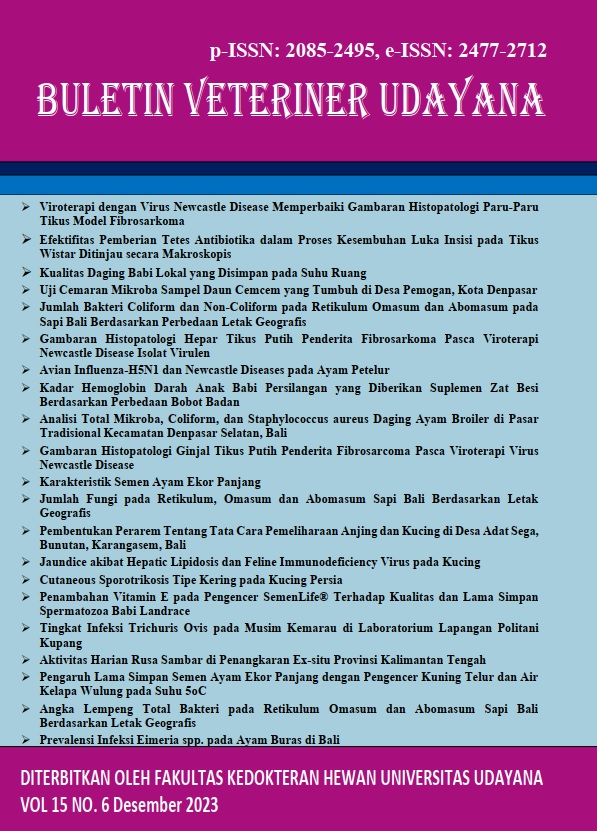NUMBER OF FUNGI IN RETICULUM, OMASUM AND ABOMASUM BALI CATTLE BASED ON GEOGRAPHICAL LOCATION
Abstract
Bali cattle are one of Indonesia's germplasm of large livestock species as a source of animal protein, Bali cattle are very well known for their superiority and their existence must be preserved. The purpose of this study was to determine the number of fungi in the reticulum, omasum and abomasum of Bali cattle based on their geographical location and to determine differences in the number of fungi in the reticulum, omasum and abomasum of Bali cattle in the lowlands and highlands. The research materials used were 32 samples from each of the contents of the reticulum, omasum and abomasum taken from the Pesanggaran slaughterhouse (RPH), Denpasar. The variables studied in this study were the number of fungal microbes found in the reticulum, omasum and abomasum of Bali cattle. The data obtained is displayed descriptively, using a qualitative observational research design with a cross-sectional study design. The mean number of fungi in the reticulum, omasum and abomasum of Bali cattle in the highlands and lowlands were respectively 90,63x105±53,475CFU/g and 51,88x105±13,276 CFU/g ; 70,63x105±32,755 CFU/g and 40,63x105±8,539 CFU/g ; 36,88x105±4,787 CFU/g and 21,88x105±4,031 CFU/g. The results of the independent t test analysis showed that the number of fungi in the reticulum, omasum and abomasum of Bali cattle in the highlands was significantly higher (P<0.05) compared to bali cattle reared in the lowlands. This research requires further research regarding the isolation and characteristics of the fungi in the reticulum, omasum and abomasum of Bali cattle in different plains locations to strengthen the research results both theoretically and practically
Downloads
References
Fardiaz S. 1992. Mikrobiologi Pangan I. Jakarta. Gramedia Pustaka Utama
Heraini D, Purwanto BP, Suryahadi. 2016. Perbandingan Suhu Lingkungan dan Produktivitas Ternak Sapi Perah Melalui Pendekatan Stochastic Frontier (Study Kasus di Peternakan Rakyat KUTT Suka Makmur). Bogor. J. Sains Terapan Edisi VI Vol-6 (1) : 16 – 24
Kadarsih S. 2004. Performans Sapi Bali Berdasarkan Ketinggian Tempat di Daerah Transmigrasi Bengkulu: Performans Pertumbuhan. J. Ilmu-Ilmu Pertanian Indon. 6(1): 50- 56
Lamid M. 2016. Peran Bioteknologi Pakan Ternak Terhadap Pertambahan Berat Badan Sapi Sebagai Upaya Pemenuhan Konsumsi Daging Nasional: Surabaya.
Marlissa FCM, Suarjana IGK, Besung INK. 2020. Jumlah Fungi Pada Cairan Rumen Sapi Bali. Denpasar. Indonesia Mediscus Veterinus 9(3): 383-391
Masitoh S. 2021. Kebutuhan Daging Sapi Nasional. Jakarta. Kontan.Co.Id https://nasional.kontan.co.id/news/kebutuhan-daging-sapi-tahun-ini-700000-ton-produksi-dalam-negri-hanya-separuhnya. Artikel ini diakses pada tanggal 28 Desember 2022 pukul 12.10 WITA
Mould FL, Kliem KE, Morgan R, Mauricio RM. 2005. In Vitro Microbial Inoculum: A Review of Its Dunction and Properties. Anim. Feed Sci. Technol. 123-124: 31 50.
Nagpal R, Puniya AK, Sehgal JP, Singh K. 2010. Influence of Bacteria and Protozoa from The Rumen of Buffalo on In-Vitro Activities of Anaerobic Fungus Caecomyces Sp.Isolated from The Feces of Elephant. J. Yeast Fungal. Res. 1 (8): 152-156.
Noor RR. 1999. Peran gen kelenturan fenotip dalam mengontrol interaksi antara faktor genotipe dengan lingkungan. Pelatihan Aplikasi Pemuliaan Mendukung Pelepasan Varietas Ikan Unggul.Bogor.
Nuriyasa IM, Dewi GAMK, Budiari NLG. 2016. Indeks Kelembaban Suhu dan Respon Fisiologi Sapi Bali yang Dipelihara Secara Feedlot pada Ketinggian Berbeda. Maj. Ilmiah Pet.18(1): 5 – 10.
Pribadi LW. 2014. Respon Pertumbuhan Sapi Bali dan Silangannya dengan Sapi Simental terhadap Perbedaan Lingkungan Termal di Pulau Lombok. J. Bionomika. 11(3): 34-41.
Purbowati EE, Rianto WS, Dilaga CMS, Lestari R, Adiwinarti. 2014. Karakteristikcairan rumen, jenis, dan jumlahmikrobiadalam rumen sapiJawa dan Peranakan Ongole. Bul. Pet. 38 (1): 21 – 26.
Purwoko. 2015. Peran Kebijakan Fiskal Dalam Peningkatan Produktvitas Pembibitan Sapi Nasional. J. Kajian Ekonomi dan Keuangan. 19(2): 97-121.
Sari NF. 2017. Mengenal Keragaman Mikroba Rumen pada Perut Sapi Secara Molekuler. Bio Trends. 8(1): 5-9.
Susilawati. 2016. Fisiologi Nutrisi Abomasum Sapi Bali Jantan. Skripsi. Mataram
Sutedjo H. 2016. Dampak Fisiologis dari Cekaman Panas pada Ternak. J. Nukleus Pet. 3(1): 93-105.
Van Soest PJ. 1994. Nutritional Ecology of the Ruminant. Second Edition. Cornell University Press. London.
West JW. 2003. Effects of heat-stress on production in dairy cattle. J. Dairy Sci. 86: 2131–2144.
Xiao R, Horton STJ, Heitman JL, Ren T. 2010. Cumulative soil water evaporation as a function of depth and time. Vadose Zone J. 10(3): 1016-1022





